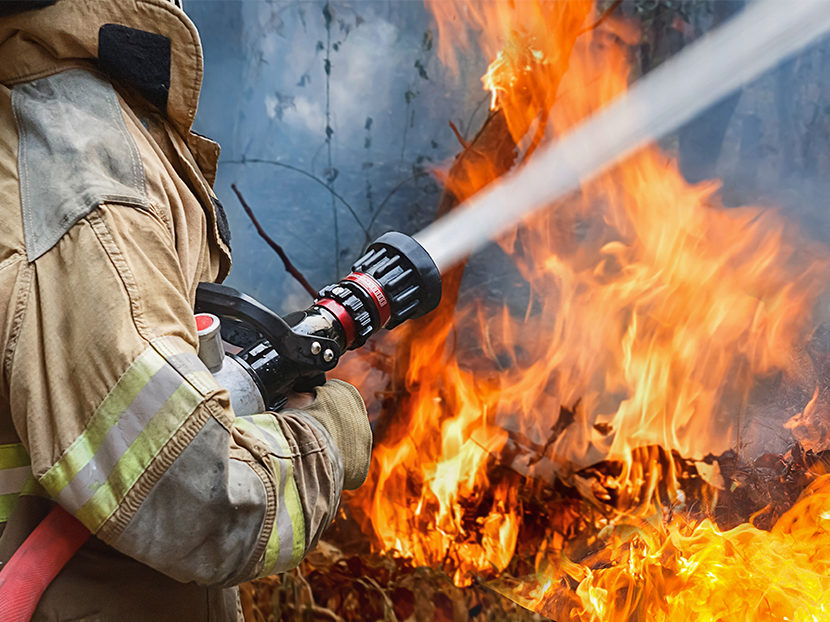Sprinklers Are Still Illegal in Hawaii
Anti-sprinkler lobbyists aren’t thinking about safety.

In a re-creation of the popular legend, which tells us Emperor Nero fiddled while Rome burned, on July 14, 2017 …
… the Building Industry Association (BIA) of Hawaii sent out an invitation for a celebratory pau hana to mark a new law that continues to prohibit counties from requiring single-family and duplex homes to have sprinklers. Within hours of the invite, a fire killed three people at the Marco Polo, a 36-story, 568-unit residential complex along Kapiolani Blvd. The building didn’t have any sprinklers.1
Fortunately, after becoming aware of the developing tragedy, BIA-Hawaii cancelled the planned celebration.
Earlier, in June of 2017, the celebration started at the signing of Senate Bill 611 by Hawaii Governor David Ige.
On June 29, 2017, Act 53 relating to Fire Sprinklers became effective. The law, Hawaii Revised Statute (HRS) 46-19.8 states:
HRS 46-19.8 Fire sprinklers; residences. No county shall require the installation or retrofitting of automatic fire sprinklers or an automatic fire sprinkler system in:
- Any new or existing detached one- or two-family dwelling unit in a structure used only for residential purposes; and
- Nonresidential agricultural and aquacultural buildings and structures located outside an urban area.
Provided that this section shall not apply to new homes that require a variance from access road or firefighting water supply requirements.
This Act shall take effect on June 29, 2017; provided that on June 30, 2027, this Act shall be repealed.
This latest version of HRS 46-19.8 repeals and replaces the version that was enacted on July 1, 2012 and was intended to sunset, i.e., be automatically repealed, five years later on June 30, 2017.
Despite strong opposition by all four county fire chiefs and the NFPA, the bill passed. Notably the legislation had overwhelming support of the home building industry, realtors, and county governments, all concerned about the impact residential sprinklers would have on the cost of homes.
So, sprinklers are still illegal in Hawaii, at least in one- and two-family dwellings. There was one small victory for the pro-sprinkler lobby. The first version of Senate Bill 611 would have permanently instituted the ban on sprinklers, which was scaled back to a 10-year ban.
The Hawaii anti-sprinkler efforts led by BIA-Hawaii were part of a well-funded, nationwide lobbying effort by the home building industry. It is using state-wide legislation to head-off any efforts by local towns, cities, and counties to adopt current editions of the International Building Code and International Residential Code (IRC), unless the requirement of sprinklers in one- and two-family dwellings are removed.
Other states that have enacted anti-residential sprinkler laws include New York, Texas, Arkansas, New Jersey, Nevada, Minnesota, and California2.
In 2012, when the first sprinkler ban in Hawaii was enacted, the housing construction industry was trying to shake itself free from the worst new home construction downturn in a decade. It was understandable that the home building industry would be sensitive to perceived increases to its costs, as it argued from the vantage point of a suffering industry. In 2017, in the midst of a virtual housing construction boom in Hawaii, BIA-Hawaii felt the increased costs would kill the boom.
It argued, on its web page asking for funds to help match the donation from the National Home Builders Association (NAHB), that if the IRC sprinkler requirements were adopted in Hawaii it … “will kill our construction and remodeling industry. It is critical to stop this insanity now3.”
Misinformation has always been an important weapon in the arsenal of the anti-sprinkler lobbyists. Written testimony offered by the BIA-Hawaii on Feb. 23, 2012 before a Hawaii Senate Committee includes the following gem, “Fire sprinklers have not been proven to enhance the safety of occupants.”
BIA-Hawaii indicated in written testimony4 on March 28, 2017 that the cost of residential sprinklers for a single-family home would be more than $35,000 on Oahu, $40,000 in Hawaii County, and $66,000 dollars in Maui.
In the same testimony, BIA-Hawaii justified the need to extend the sprinkler ban based on these “facts”:
- With smoke alarms, the additional benefit of sprinklers does not warrant their additional cost;
- Newer homes are safer; and
- Systems will quickly become ineffective due to lack of maintenance.
These, along with other myths being used against residential sprinklers, are well-refuted by NFPA5.
What anti-sprinkler lobbyists fail to understand is that the IRC sprinkler requirements were put in place in part to address the increased hazards related to contents in modern homes and in part to enable builders to use increased lightweight building construction materials in home construction. Lightweight engineered lumber projects have been implicated in several firefighter deaths. When these products are exposed to fire, they can fail quickly and with little notice. A report by the International Society of Fire Service Instructors and Eastern Kentucky University’s Fire and Safety Engineering Technology Program, which studied 117 firefighter fatalities between 1996 and 2009, found that lightweight construction was found as a factor in 17 firefighter fatalities occurring in 12 separate fire incidents. Ten of those incidents were in residences.
Sprinklers enable the use of high-tech lumber to reduce the cost of home construction. Sprinklers were used as partial justification to head off efforts from concerned public safety groups, including firefighter unions, to ban these products from residential codes because of their poor performance in fires. And now the home builders are coordinating a highly successful nationwide campaign to use the government to backdoor the codes so they can have their cake and eat it too.
This method of attacking consensus standard codes by using the government to essentially create, or at least revise code is disturbing and hopefully will not become a model for others who cannot get their way through the legitimate standards making process.
The home building industry argues it is not against sprinklers, it simply wants sprinklers to be optional.
One wonders how many prospective new homeowners are being offered that option.
Oh, by the way, in case you do not know what pau hana means: It is Hawaiian pidgin for “finished working” and has the extended meaning of happy hour.
Footnotes:
- Industry Cancels Celebration of Ban On Sprinkler Requirements
- The Fire Sprinkler War, State by State: From New York to Minnesota, how homebuilders headed off mandatory fire sprinklers with help from friendly legislators., by Robert Faturechi, ProPublica, June 22, 2016
- Fire Sprinkler Info
- Testimony to the House Committee on Consumer Protection & Commerce, March 28, 2017 RE: SB 611 SD1 HD1–Relating to Fire Sprinklers
- NFPA Myths Versus Facts





